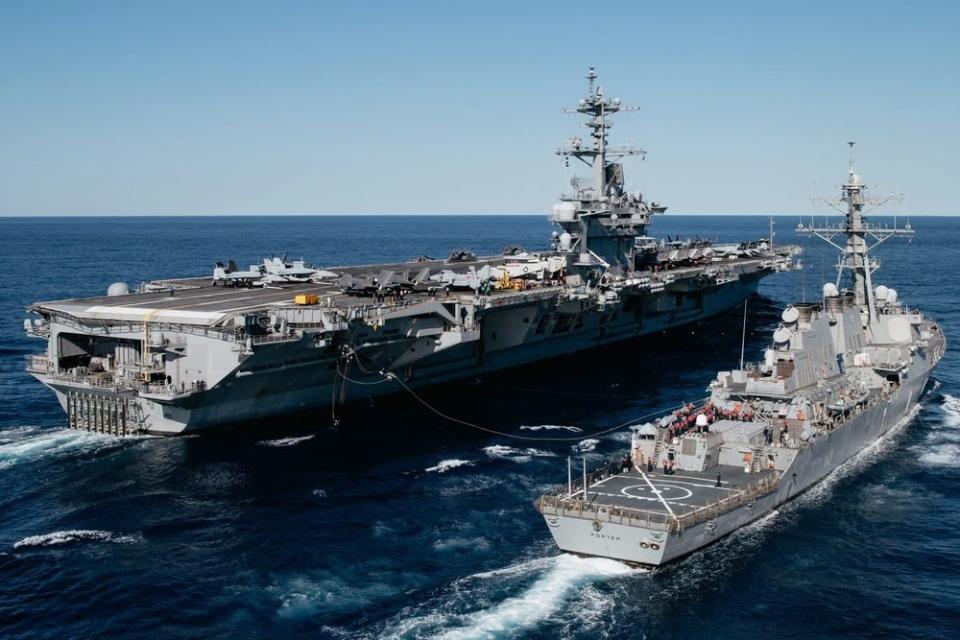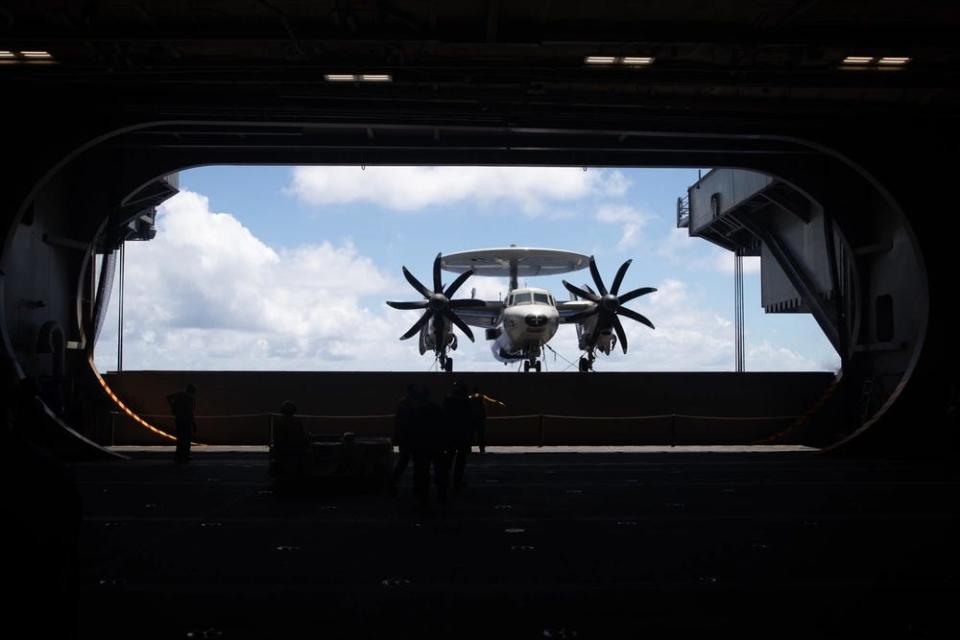See aboard USS George Washington, an aircraft carrier with a checkered recent history
USS George Washington departed for South America before heading to its new homeport in Japan.
It was deployed for the first time in nearly a decade to replace USS Ronald Reagan in Yokosuka.
Nine sailors died by suicide while the ship underwent a major overhaul that took nearly six years.
USS George Washington, the Nimitz-class nuclear-powered aircraft carrier, departed Naval Station Norfolk in Virginia last month for its new homeport in Japan.
On April 25, the GW was deployed to participate in maritime exercises in the US Southern Command area of operations, marking the vessel's first deployment in nearly a decade after its midlife refueling.
The GW is finally operational after an extended and troubled time going through a major overhaul.
'Team Warfighter is ready to go'

The Washington is set to replace USS Ronald Reagan at the US Navy's naval base in Yokosuka as the service's only forward-deployed aircraft carrier. The Reagan is heading to the Bremerton shipyard in Washington for maintenance.
"Team Warfighter is ready to go," Capt. Tim Waits, commanding officer of George Washington, said in a statement, "not only for the adventure that awaits in South America but ready to serve as the nation's forward-deployed naval forces carrier in Yokosuka."
Southern Seas 2024

Along with the Washington, guided-missile destroyer USS Porter and replenishment oiler USNS John Lenthall are scheduled to conduct exercises and operations at sea with other allied maritime forces in South America for Southern Seas 2024.
Fourth US Navy ship named after the first US president

Built by Huntington Ingalls Industries' Newport News Shipbuilding, the GW is the Navy's sixth Nimitz-class aircraft carrier and the fourth vessel to bear the name of the first US president. The 1,092-foot-long steel vessel accommodates more than 6,000 crewmembers.
The Washington can carry up to 90 fixed-wing and rotary-wing aircraft, including F-35 Lightning and F/A-18 Super Hornet fighter jets.
Armed seagoing airbase

In addition to its primary purpose as a seagoing airbase, the vessel is also equipped with a 20mm radar-guided air-defense gun, a Sea Sparrow surface-to-air missile launcher, and two RIM-116 Rolling Airframe Missile launchers.
First nuclear-powered warship permanently stationed outside the US

Since its commission in 1992, the GW has played key roles in several operations over the last three decades. The ship was deployed to provide air support to New York City following the 9/11 attacks and later to the Mediterranean Sea and the Persian Gulf as part of the US campaign against terrorism.
In 2008, it replaced the first-in-class USS Kitty Hawk as the forward-deployed carrier at Yokosuka, becoming the first nuclear-powered surface warship to be permanently stationed outside the US.
A troubled stay at the shipyard

Last May, the Washington was redelivered to the Navy after a challenging nearly six years in the shipyard.
In 2017, the ship began its midlife refueling and complex overhaul (RCOH) at Newport News Shipbuilding in Virginia, which normally takes four years to repair and upgrade nearly every system and space on the vessel. This includes the time-consuming tasks of removing the reactor's spent core and replacing it with one that has rods fresh with enriched uranium.
The refitting process was delayed amid supply chain issues and staffing shortages brought on by the COVID-19 pandemic, as well as other higher-priority shipbuilding projects taking precedence over the Washington's maintenance.
An unprecedented streak of suicides

During the almost six-year-long maintenance period, an unprecedented string of suicides — a number of whom were junior sailors — occurred among the Washington's crew.
Following several complaints from the crew and the deaths of three sailors by suicide within a week, the Navy launched a series of investigations into the quality of life aboard the carrier in April 2022.
While the monthlong investigation concluded that the deaths were "not related or connected," it found it was a result of "unique and individualized" challenges they faced aboard the GW during the major overhaul.
Months turn into years

Investigators found Navy leadership failed to address uninhabitable living conditions for sailors who moved back aboard the ship prematurely due to housing shortages at the shipyard.
A crew usually returns to reside on their assigned ship within six to nine months before it is redelivered to the Navy. When sailors moved back aboard the Washington, the expected redelivery was August 2022, but shipyard delays led to crews living aboard the ship for nearly two years.
Crewmembers assigned to vessels in the shipyard reside in Huntington Hall, a 149-unit residence building operated by HII. The Navy spends more than $4 million to provide housing for eligible personnel.
Uninhabitable living conditions

But as shipbuilding and repair projects at Newport News piled up, so did the number of crew who needed accommodation. Lower-ranking sailors who were not given a basic housing allowance to help pay for off-base apartments were forced to live aboard the ship before it was ready, lacking hot water and privacy, facing power outages, and enduring unbearable temperatures.
One of the Navy's investigations found that sailors who weren't living aboard the ship resorted to sleeping in their cars or paying for rent in the Norfolk area. Some sailors faced complicated commutes lasting up to three hours, involving unpredictable traffic, catching shuttle buses, and mile-long walks.
"Collectively, Navy senior leadership, officer and civilian, let our standards slip — and in doing so, we let our people down," Navy Secretary Carlos Del Toro and then-Chief of Naval Operations Adm. Michael Gilday in a memo.
'Reduced quality of life in the shipyard'

Surveys conducted while the vessel was in the shipyard found that the crew had the highest number of suicidal ideation and suicide attempts compared to all aircraft carriers on the East Coast from 2017 to 2019.
Despite a sharp rise in "awareness of suicidal ideations" while the Washington underwent the overhaul, the Navy's report found that leadership missed the warning signs.
"It is safe to say that generations of Navy leaders had become accustomed to the reduced quality of life in the shipyard and accepted the status quo as par for the course for shipyard life," Rear Adm. John Meier, now-retired commander of Naval Air Force Atlantic, said in an October 2022 investigation report. "As senior sailors, it is easy to forget our Navy life in the beginning."
The ship's assigned officers receive housing allowances and typically only stay aboard the ship for duty or overnight maintenance projects.
'Shipyard environment is always a challenge'

According to USNI News, of the 42 sailors assigned to aircraft carriers who died by suicide from 2017 to 2022, nine of them were assigned to the GW.
Cmdr. Dawn Stankus, a spokesperson for Naval Air Force Atlantic, told Military.com that the "shipyard environment is always a challenge."
"When you're in a shipyard, you don't necessarily get to do what you signed up to do in the military," Stankus added.
A 2023 Pentagon report found that the Navy had a suicide rate of 20.6 deaths per 100,000 sailors — the highest in four years.
More mental health resources

The Navy is taking strides to improve the quality of life for sailors aboard the Washington.
Kellylynn Zuni, the GW's clinical psychologist, told Health News Florida that the permanent mental health staff on the ship has doubled, allowing them to see any sailor who needs immediate help. The Navy is also creating a psychiatrist intervention team to provide mental health care in emergencies.
In February, the ship also opened a new rest and recreation area for sailors that includes a library, TV, videogames, computers, and phones to stay in contact with their families.
"The underlying theory there is by improving quality of service — which is the combined effort of quality of life and quality of work — we believe that that reduction in friction in a sailor's life will be one less thing in their rucksack if you will," Adm. Daryl Caudle, commander of Fleet Forces, told USNI News in October.
Caudle continued: "But the premise is if I can lower that stress and lower what's on sailors by making their quality of life and quality of work more efficient, more effective, more desirable, then the propensity to actually think about completing suicide will not be on the table."
If you or someone you know is experiencing depression or has had thoughts of harming themself or taking their own life, get help. In the US, call or text 988 to reach the Suicide & Crisis Lifeline, which provides 24/7, free, confidential support for people in distress, as well as best practices for professionals and resources to aid in prevention and crisis situations. Help is also available through the Crisis Text Line — just text "HOME" to 741741. The International Association for Suicide Prevention offers resources for those outside the US.
Read the original article on Business Insider


